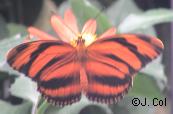
 |
| You might also like: | Butterfly Glossary: W | Butterfly Glossary: V | Butterfly Glossary: D | Butterfly Glossary: Q | Butterfly Glossary: I | Today's featured page: Butterfly Classification |
Table of Contents |
Enchanted Learning ALL ABOUT BUTTERFLIES! |
Butterfly Calendar |
| What is a Butterfly? | Life Cycle | Butterfly Anatomy | Information Sheets | Glossary | Printables and Activities |
| Butterfly Glossary |
| A | B | C | D | E | F | G | H | I | J | K | L | M | N | O | P | Q | R | S | T | U | V | W | X-Z |
 OAK TIGER BUTTERFLY The oak tiger butterfly, also called the banded orange butterfly (Dryadula phaetusa) is an orange and black butterfly found from Northern Mexico to Brazil. The undersides of the wings have brown and tan stripes. Classification: Family Nymphalidae, Genus Dryadula, Species D. phaetusa. |
OBTECT PUPA An obtect pupa is a pupa whose legs are held closely to the body and are unable to move. A butterfly chrysalis is an obtect pupa. |
OCELLUS (plural ocelli) Ocelli (also called stemma, pl. stemmata) are small, simple eyes that insects have. They are composed of photoreceptors (light-sensitive cells) and pigments. Ocelli are usually located on the larva's head or between an adult insect's two compound eyes. Moths have a pair of ocelli. |
OMNIVORE Omnivores are animals that eat both animals and plants. People are omnivores. |
OMMATIDIUM (plural omnitidia) The ommatidia are the parts of an insect's compound eye which receive light from a small part of the insect's field of vision. Each ommatidium is a cylindrical unit composed of a hexagonal lens-cornea and crystalline cone (which receive the light and focus it) plus a rhabdome (which is stimulated by light and sends signals to the optic nerve to the brain). |
 ORANGEDOG BUTTERFLY The orangedog butterfly, also called the giant swallowtail butterfly (Papilio cresphontes) is a large black and yellow butterfly with a yellow body. Eggs are tiny, yellow and circular. The caterpillar, which looks a bit like a small, black, white, and brown snake, is considered a pest (because it eats many agricultural species, including orange tree leaves). The chrysalis is brown. This butterfly lives in much of North America. Classification: Family Papilionidae (swallowtail butterflies), Genus Papilio, Species P. cresphontes. |
ORANGE SULPHUR BUTTERFLY (Colias eurytheme) The Orange Sulphur Butterfly is a common and widespread North American butterfly. It has a wingspan of 1 3/8 to 2 3/4 inches (3.5 - 7 cm). The male is yellow with orange, yellow veins, black edges, and a dark black spot. The female is yellow or white with a thin black border surrounding cream spots. Caterpillars eat plants from the pea family, including alfalfa, white clover, and white sweet clover. Adults drink nectar from dandelions, milkweeds, goldenrods, and asters. This butterfly was named by Boisduval in 1862. Classification: Family Pieridae (Whites and Sulphurs), Subfamily Coliadinae (Sulphurs) |
ORDER In classification, an order is a group of related or similar organisms. An order contains one or more families. A group of similar orders forms a class. Butterflies and moths belong to the Order Lepidoptera. |
OREGON SILVERSPOT BUTTERFLY Speyeria zerene hippolyta is a brown and orange butterfly that lives in humid coastal salt-spray meadows and fields from Northern California to Washington. This butterfly is a threatened species due to loss of habitat and the decline of its host plant (the plant the caterpillar eats), the Early Blue Violet (Viola adunca). Adults eat yarrow, Canadian goldenrod, and Douglas aster. Females can lay over 200 cream to pink eggs (60 percent hatch), usually under the violet plant. Classification: Family Nymphalidae |
OSMETERIUM An osmeterium is an orange, y-shaped gland on the neck of some caterpillars. This gland gives off a strong, unpleasant odor when the caterpillar is threatened, keeping away dangerous wasps and flies that try to lay eggs in the caterpillar. Many swallowtails have an osmeterium. |
OUTCROPPING An outcropping is a place where the bedrock (the underlying rock) is exposed on the Earth's surface. |
OVERWINTERING Overwintering (also called hibernation) is a condition in which an animal is dormant for period of time. Some butterflies and moths overwinter during cold weather. |
OVIPAROUS Oviparous animals hatch from eggs. Butterflies and moths are oviparous. Butterflies usually lay their eggs on leaves of the plant that the larva (caterpillar) will eat. |
OVIPOSITOR An ovipositor is a an organ at the end of the female's abdomen through which she deposits her eggs. |
Butterfly Glossary |
|||||||
| A | B | C | D | E | F | G | H | I | J | K | L | M | N | O | P | Q | R | S | T | U | V | W | X-Z |
Enchanted Learning®
Over 35,000 Web Pages
Sample Pages for Prospective Subscribers, or click below
|
Overview of Site What's New Enchanted Learning Home Monthly Activity Calendar Books to Print Site Index K-3 Crafts K-3 Themes Little Explorers Picture dictionary PreK/K Activities Rebus Rhymes Stories Writing Cloze Activities Essay Topics Newspaper Writing Activities Parts of Speech Fiction The Test of Time
|
Biology Animal Printouts Biology Label Printouts Biomes Birds Butterflies Dinosaurs Food Chain Human Anatomy Mammals Plants Rainforests Sharks Whales Physical Sciences: K-12 Astronomy The Earth Geology Hurricanes Landforms Oceans Tsunami Volcano |
Languages Dutch French German Italian Japanese (Romaji) Portuguese Spanish Swedish Geography/History Explorers Flags Geography Inventors US History Other Topics Art and Artists Calendars College Finder Crafts Graphic Organizers Label Me! Printouts Math Music Word Wheels |
Click to read our Privacy Policy
| Search the Enchanted Learning website for: |